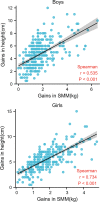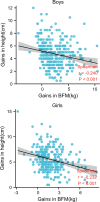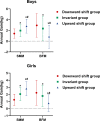The Different Effects of Skeletal Muscle and Fat Mass on Height Increment in Children and Adolescents Aged 6-11 Years: A Cohort Study From China
- PMID: 35937846
- PMCID: PMC9352863
- DOI: 10.3389/fendo.2022.915490
The Different Effects of Skeletal Muscle and Fat Mass on Height Increment in Children and Adolescents Aged 6-11 Years: A Cohort Study From China
Abstract
Objective: This study aimed to investigate the contribution of body composition including skeletal muscle mass (SMM) and body fat mass (BFM) to longitudinal growth among children and adolescents aged 6-11 years old.
Methods: This cohort study was conducted from the annual health examination between 2019 and 2020. Annual height gain and weight gain and changes in SMM and BFM were calculated and compared between sexes, different nutritional status, and growth curve shifting mode. Spearman analyses and multiple linear regression analysis were performed to identify the impact of SMM, BFM, or body mass index (BMI) on height gain.
Results: Of the 584 subjects, the annual height gains of boys (4.76 cm in the 6-9-year group and 4.63 cm in the 10-11-year group) were significantly lower than those of girls (5.48 and 5.74 cm, respectively). Spearman analysis showed that SMM gain and height gain were positively and significantly correlated in each examination of all children (r = 0.535 for boys and 0.734 for girls, p < 0.001). Conversely, BFM and height gains were negatively (r = -0.5240 for boys and -0.232 for girls, p < 0.001) correlated. Multiple linear regression analysis identified SMM gain as an independent predictor (95% CI: 1.20,1.44) of height gain after adjusting for age, gender, BMI, BFM gain, and percentage of body fat (PBF).
Conclusion: SMM gains, rather than BFM gains, were associated with height gains in children and adolescents aged 6-11 years. Monitoring SMM changes in routine healthcare might motivate children and adolescents to achieve dietary and exercise recommendations, thereby growing taller without gaining excessive weight.
Keywords: adolescent; children; fat mass; height increment; skeletal muscle.
Copyright © 2022 Wu, Shi, Xu, Zeng, Lin, Li, Zhao, Zhu, Fu, Li and Dong.
Conflict of interest statement
The authors declare that the research was conducted in the absence of any commercial or financial relationships that could be construed as a potential conflict of interest.
Figures






Similar articles
-
[Reference values of skeletal muscle mass for children in Nanjing area].Zhonghua Er Ke Za Zhi. 2024 May 2;62(5):423-429. doi: 10.3760/cma.j.cn112140-20240109-00036. Zhonghua Er Ke Za Zhi. 2024. PMID: 38623009 Chinese.
-
Skeletal Muscle Mass Has Stronger Association With the Risk of Hyperuricemia Than Body Fat Mass in Obese Children and Adolescents.Front Nutr. 2022 Mar 28;9:792234. doi: 10.3389/fnut.2022.792234. eCollection 2022. Front Nutr. 2022. PMID: 35419385 Free PMC article.
-
Reference Values of Skeletal Muscle Mass for Korean Children and Adolescents Using Data from the Korean National Health and Nutrition Examination Survey 2009-2011.PLoS One. 2016 Apr 13;11(4):e0153383. doi: 10.1371/journal.pone.0153383. eCollection 2016. PLoS One. 2016. PMID: 27073844 Free PMC article.
-
Visceral adiposity and inflammatory bowel disease.Int J Colorectal Dis. 2021 Nov;36(11):2305-2319. doi: 10.1007/s00384-021-03968-w. Epub 2021 Jun 9. Int J Colorectal Dis. 2021. PMID: 34104989 Review.
-
[Simple obesity in children. A study on the role of nutritional factors].Med Wieku Rozwoj. 2006 Jan-Mar;10(1):3-191. Med Wieku Rozwoj. 2006. PMID: 16733288 Review. Polish.
Cited by
-
Segmental fat-free mass and lean soft mass: a comparative study with dual X-ray absorptiometry (DXA), bioelectrical impedance analysis (BIA) and anthropometry and development of anthropometric prediction models.J Int Soc Sports Nutr. 2025 Dec;22(1):2542368. doi: 10.1080/15502783.2025.2542368. Epub 2025 Aug 5. J Int Soc Sports Nutr. 2025. PMID: 40762907 Free PMC article.
-
The Creeping Creatinine in a Growing Child With a Kidney Transplant: Distinguishing Progressive Graft Dysfunction From Normal Growth in Pediatric Kidney Transplant Recipients.Pediatr Transplant. 2025 Feb;29(1):e14883. doi: 10.1111/petr.14883. Pediatr Transplant. 2025. PMID: 39725645 Free PMC article.
-
Insufficient Muscle Development Level Associated with Serum Zinc, Manganese and Cobalt Levels in Children Aged 6 to 9 Years in Shenzhen, China.Biol Trace Elem Res. 2025 Jul;203(7):3665-3677. doi: 10.1007/s12011-024-04458-0. Epub 2024 Nov 23. Biol Trace Elem Res. 2025. PMID: 39578349
-
Predictable anconeus dimensions with limited influence from patient size: implications for surgical planning and applications.JSES Rev Rep Tech. 2025 May 22;5(3):541-544. doi: 10.1016/j.xrrt.2025.04.014. eCollection 2025 Aug. JSES Rev Rep Tech. 2025. PMID: 40697289 Free PMC article.
References
-
- Screening Standard for Malnutrition of School-Age Children and Adolescents (2014), WS/T 456–2014. http://std.samr.gov.cn/hb/search/stdHBDetailed?id=8B1827F20C41BB19E05397...
-
- Screening for Overweight and Obesity Among School-Age Children and Adolescents (2018).
Publication types
MeSH terms
LinkOut - more resources
Full Text Sources

